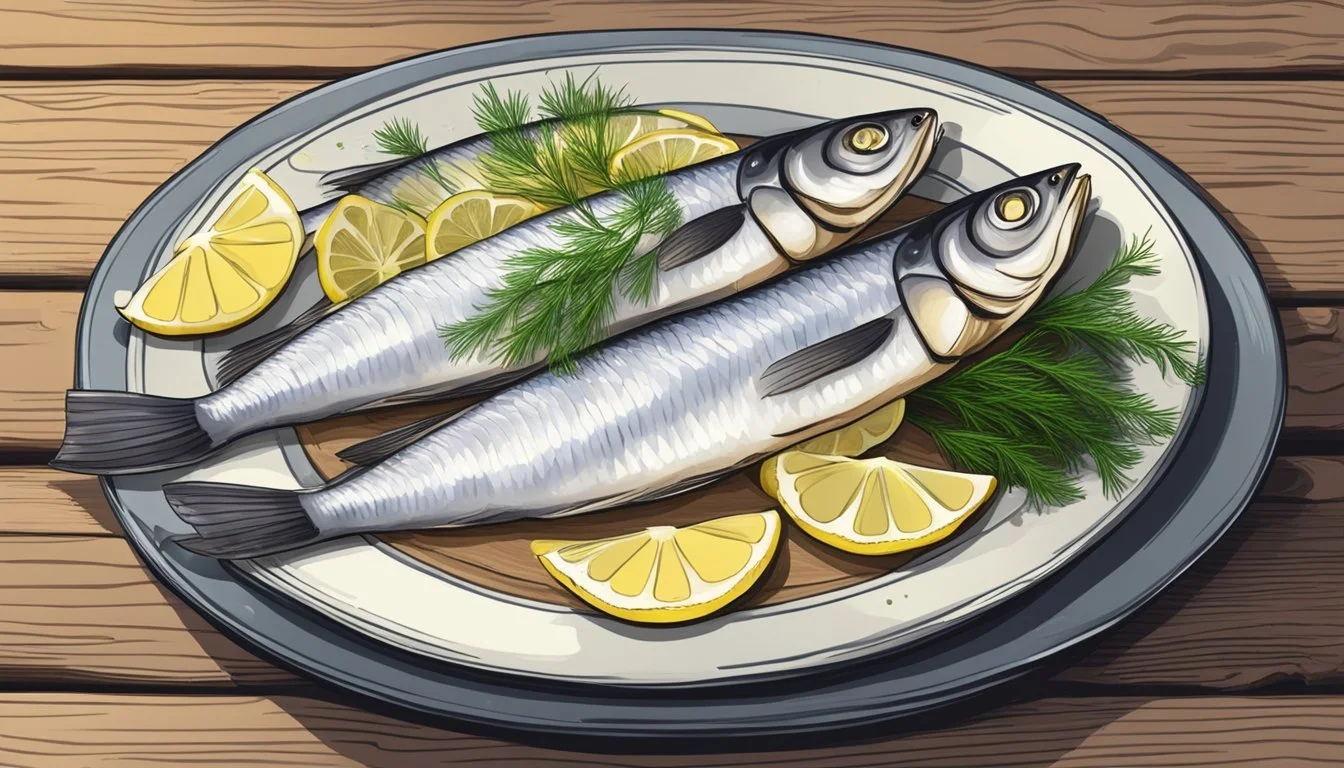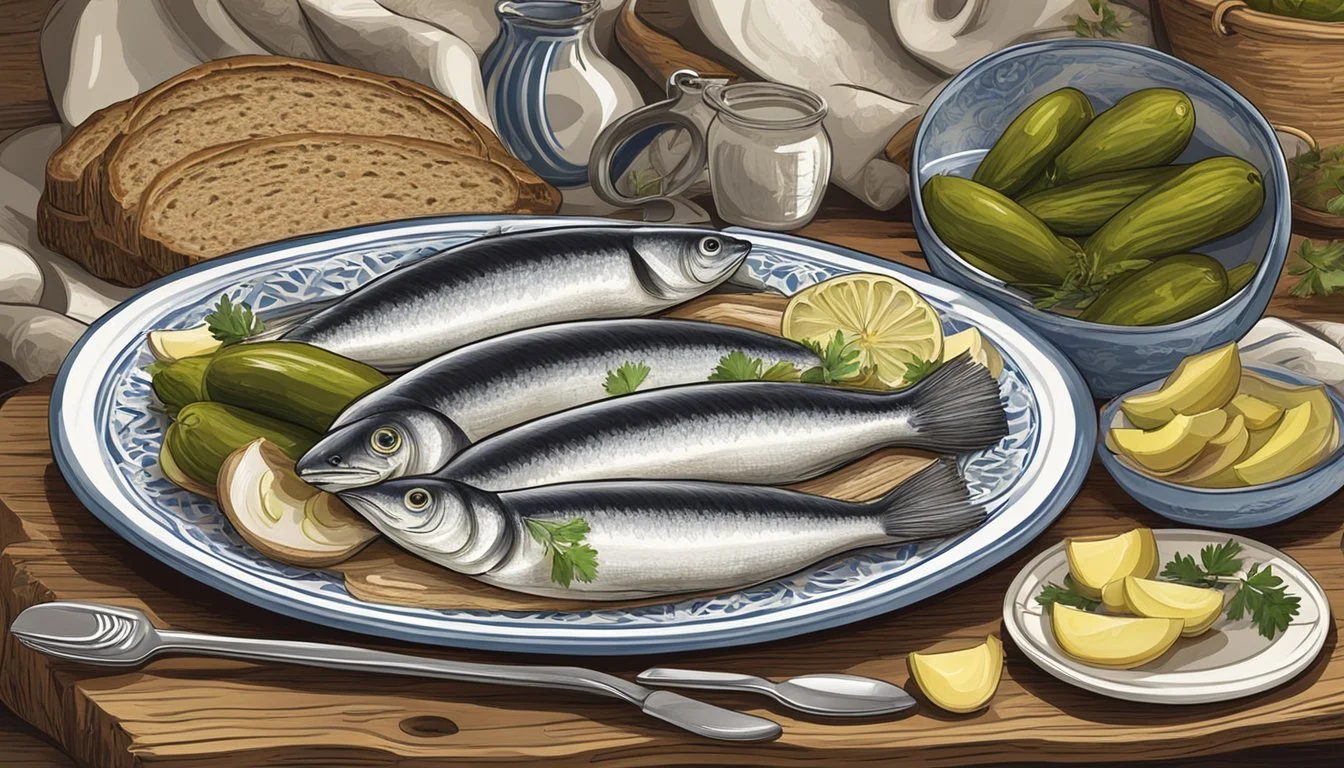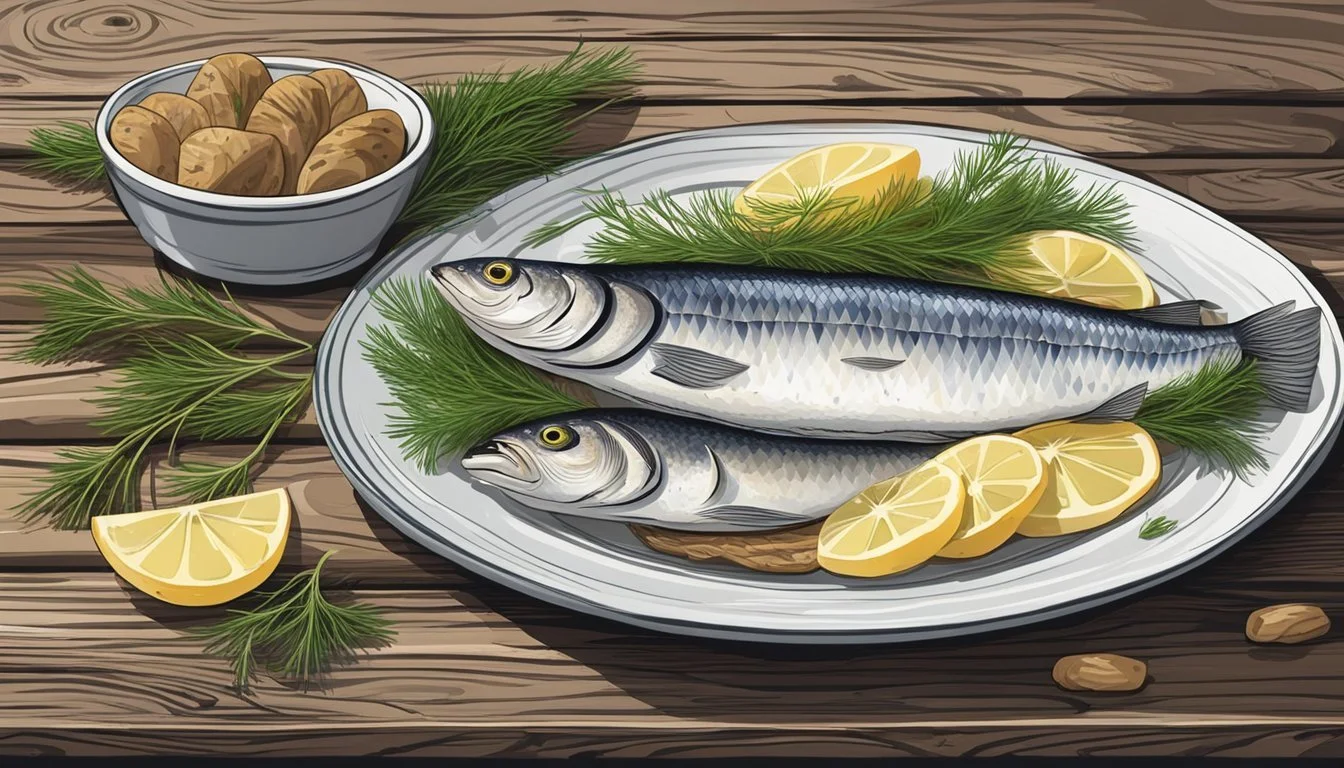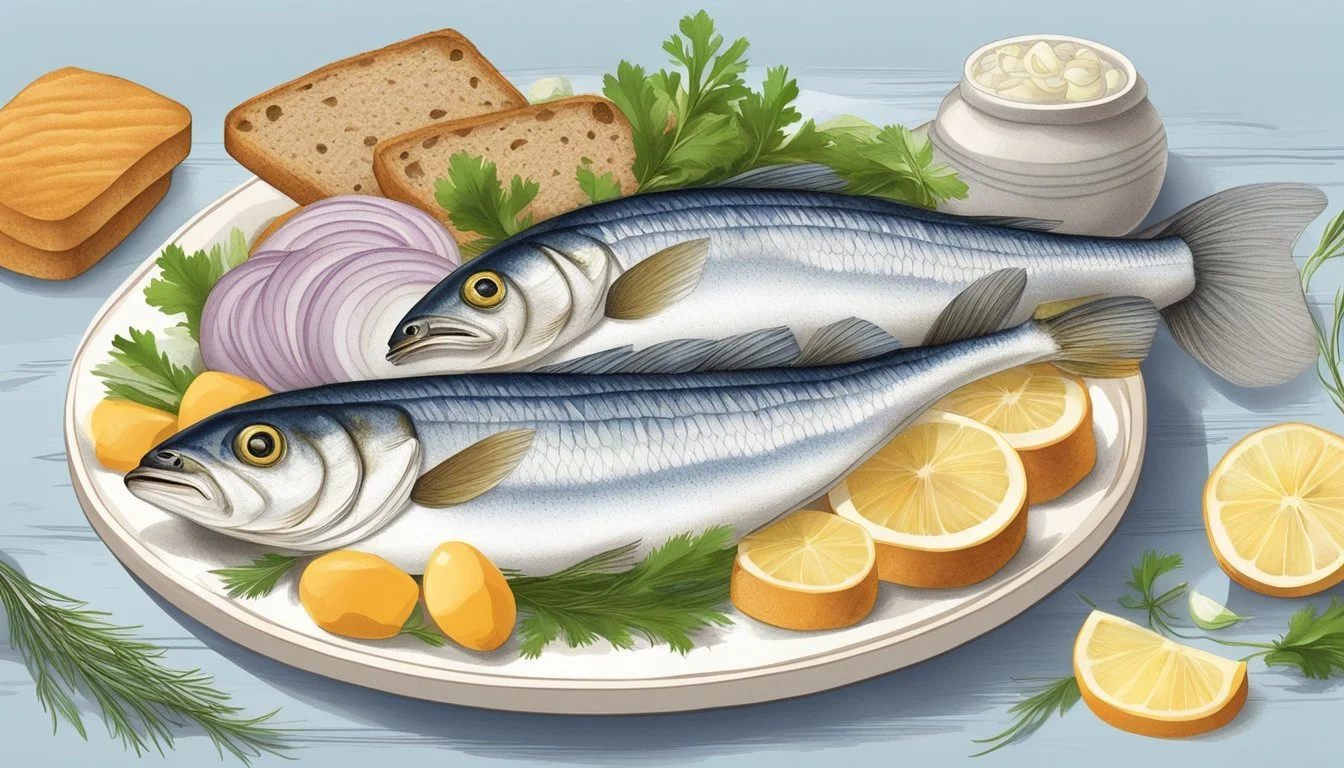Matjes Herring
A Guide to the Delicate Flavor of Northern Europe
Matjes herring, also known as Dutch new herring or just maatjes, is a culinary delight celebrated in Northern European cuisine, particularly in the Netherlands, Germany, and Scandinavia. This delicacy is made from young, immature herrings that are caught before they have had a chance to spawn. The fish are then traditionally matured in a salty solution within oak barrels, utilizing the natural enzymes found in their pancreases to aid in the ripening process. The result of this careful preparation is an especially tender and mild salt herring.
Preparation of matjes herring is a process steeped in tradition, dating back centuries in European coastal communities. After being caught, the herring are partially gutted, leaving the pancreas in, which is key to the unique maturing method. They undergo a salting procedure and are often briefly frozen to enhance food safety. Upon reaching the ideal level of maturation, the herring acquire a soft texture and a gentle, subtle flavor that sets them apart from other preserved fish. These characteristics have made matjes a popular choice to be enjoyed on their own or as an ingredient in various dishes.
Understanding Matjes Herring
Matjes herring, a seasonal delicacy from Northern Europe, is renowned for its tender flesh and mild flavor. It is especially connected to culinary traditions in Scandinavia and the Netherlands.
Historical Significance
Matjes herring has played a pivotal role in Northern European culture, especially in the Netherlands where it has been a culinary staple since the Middle Ages. The Dutch Golden Age saw the rise of herring fishing, which not only fed the population but also fueled the growth of the Dutch merchant navy, cementing herring's role in the nation's history and economy.
Northern Europe: Central to traditional diets; an economic staple.
The Dutch Golden Age: Expansion of herring fishing; the birth of 'Hollandse Nieuwe'.
Defining Characteristics
Matjes, or maatjes, refers to young, immature herring which are typically caught before they have spawned. They are distinguished from regular herring by their high fat content and the enzyme-rich pancreas left intact during processing, which contributes to their delicate texture and maturation.
Young herring: Typically caught from late May through June, at the peak of the season.
Enzymes: The pancreas is left in during pickling to enhance flavor through the action of natural enzymes.
The term Hollandse Nieuwe applies specifically to Dutch herring that meets certain criteria for preparation, ensuring the authentic taste and quality revered in the Netherlands and beyond.
Criteria for Hollandse Nieuwe: Must be caught at a specific time of year and prepared with traditional methods.
Matjes herring is traditionally enjoyed fresh, often served with accompaniments like onions, (What wine goes well with onions?) and is cherished throughout Northern Europe and Scandinavia for its unique and subtle flavors that are reflective of the region's culinary heritage.
Culinary Importance
Matjes herring occupies a significant place in Northern European culinary traditions. Its distinct flavor and preparation method contribute to its stature as a sought-after delicacy in regional cuisines.
Taste Profile
Matjes herring is renowned for its soft, young, and tender flesh, with a mildly salted flavor profile that sets it apart from other preserved fish. It achieves its unique taste and tenderness through a traditional curing process using a combination of salt and sugar, a technique that highlights the fish's natural sweetness while subduing its inherent fishiness. The fillets are often enhanced with dill and other spices, lending them aromatic notes that pair well with various accompaniments such as cider, beer, wine, or even tea.
Cuisine Integration
In the culinary scopes of the Netherlands and Germany, Matjes herring, also called "Hollandse Maatjes," is a cornerstone, integrated through various traditional and contemporary dishes.
Dutch Cuisine:
Often served with chopped onions and pickles.
A component in "Herring Salad" combined with beets and apples.
German Cuisine (What Wine Pairs Perfectly With German Cuisine):
Featured in "Hausfrauenart," a dish where herring is marinated with yogurt or cream, spices, and fruit.
This integration exemplifies the versatility of Matjes herring, as it can be appreciated in its pure form or as a component that adds depth to salads, appetizers, and main courses. The preservation process using a mix of vinegar, salt, and sugar not only ensures the longevity of the product but also imparts a palate-pleasing pickled note, allowing it to infuse its flavors into the broader array of Northern European cuisine.
Production Methods
Matjes herring production is a meticulous process that combines traditional techniques with precise timing to ensure the delicacy's unique flavor and texture. The process begins with catching and selecting the right herring, followed by careful preservation, and concludes with a unique ripening process.
Catching and Selecting
Matjes herring are young, immature herrings caught mainly in the North Sea and Baltic Sea. The selection process is critical; only the finest herring with a high fat content, usually above 16%, are chosen. This is typically achieved during the late spring, when the herring have fed on plankton-rich waters, leading to their optimal fat content.
Processing and Preservation
Once caught, the herring are swiftly processed to preserve their delicate taste. Freezing or refrigeration are essential methods to maintain the quality of the fish before processing. The traditional preservation of Matjes herrings involves brining, a process where the fish are placed in a salt solution (brine). Key elements in preservation include:
Marinating: To enhance flavor while preserving.
Drying: Reduction of moisture to extend shelf life.
Smoking: Infrequent, but adds a distinctive taste.
Ripening and Flavoring
The unique taste of Matjes herring is developed during the ripening process. After brining, the herrings are typically ripened in wooden barrels, often made from oak, which contributes to their distinct flavor. Natural enzymes from the fish's pancreas play a vital role in this process. The herring are left to mature in these oak barrels, resting in brine for several days, which allows the flavors to intensify and the texture to soften. Pickling in various seasonings can also be part of the flavoring process, but the key is the enzyme-induced ripening which sets Matjes apart from other preserved herrings.
Traditional Servings and Recipes
Matjes herring, a young and tender fish delicacy, is traditionally served across various regions in Northern Europe. This section explores the customary ways to present matjes herring and the diverse recipes that highlight its delicate flavor.
Serving Suggestions
Matjes herring is commonly enjoyed in a variety of ways that accentuate its mild, sweet taste. One of the traditional methods is to serve it with a side of boiled potatoes or fried potatoes, which offers a textural contrast to the tender fish. Pickled herring and rollmops—herring fillets rolled into a cylindrical shape around a savory filling like a pickled gherkin or onion—are also popular.
Additionally, matjes herring can be incorporated into sandwiches, often seen in the German Fischbrötchen, where the herring is placed in a bun with raw onion, and sometimes a hard-boiled egg or garnishing such as chives. Soused herring, which involves preserving the fish in a mild preserving liquid, is another common preparation, often served with raw onion or sour cream to balance the flavors.
Recipe Variations
Several recipes have emerged to celebrate the versatility of matjes herring, with the following being some notable variations:
Cream Sauce Preparation: Mixtures of cream, sour cream, and yogurt create a rich sauce that complements the oily fish. Ingredients such as onion, apple, or pear slices provide additional freshness and can be mixed in before refrigerating to allow the flavors to meld.
Vinaigrette Dressing: Whisking together vinegar, oil, salt, and pepper to emulsify and pouring over the herring adds a tart counterpoint to the fish's natural sweetness.
Herb and Spice Infusions: Enhancing the matjes herring with layers of chopped onions and fresh dill or other herbs can infuse the fish with aromatic complexity.
Across these variations, maintaining the integrity of the herring's flavor is paramount. Fresh ingredients like chopped onion, apple, or garnishing such as chives and dill, when used thoughtfully, can elevate the dish while respecting its traditional roots.
Nutritional Information
Matjes herring is a source of high-quality protein and contains healthy fats which contribute to its nutritional value.
Health Benefits
Matjes herring provides essential nutrients that are beneficial for health. They are particularly known for their protein content, which is crucial for muscle repair and growth. The fish is also rich in omega-3 fatty acids, a type of unsaturated fat that supports heart health and may have anti-inflammatory effects.
Protein: A serving of Matjes herring offers a substantial amount of protein, which is necessary for various bodily functions, including the maintenance of tissues and the immune system.
Fat: Although Matjes herring contains fats, these are mostly in the form of omega-3 fatty acids, which have been shown to be beneficial for cardiovascular health.
Consumption of this delicacy, in moderation, can contribute to a balanced diet, providing necessary nutrients while also offering the benefits of healthy fats.
Cultural and Economic Impact
Matjes herring has had a lasting effect on the cultural traditions and economies of Northern Europe, where this delicacy's popularity parlays into significant economic activity.
Regional Traditions
Northern European countries cherish Matjes herring as part of their culinary identity. In the Netherlands, the celebration of the 'Hollandse Nieuwe'—young Dutch brined herring—signals an annual tradition where the first catch is auctioned, fetching high prices and marking the start of the season. Dutch herring fleets, established as early as the 14th century, have paved the way for this tradition, which remains woven into the cultural fabric of the region. Similarly, Nordic countries such as Denmark, Norway, and Finland have their variations, with each integrating herring into local fare and festive occasions.
In Germany, there is the famed 'Glückstädter Matjes,' a designation that denotes herring caught and processed in the region of Glückstadt. Preservation methods have played a pivotal role in the long-standing tradition of consuming Matjes herring, often involving mild salting and maturation to achieve the characteristic tender and rich taste.
Market and Economy
The economy surrounding Matjes herring is robust, linked directly to the livelihoods of fishermen and the broader fishery industry in Northern Europe. The economic impact is multi-faceted; it involves the fishing, processing, and distribution sectors, which collectively contribute to the regional economies of countries like the Netherlands, Denmark, Norway, and Finland, where herring fishing is a linchpin of coastal communities.
Furthermore, Matjes herring holds a niche yet notable space within Jewish cuisine, having been historically imported into New York City and other areas with significant Jewish populations, adding an international dimension to its market presence. The fish's economic reach extends beyond local and national borders, influencing trade routes and fostering economic ties between exporting and importing countries. This international trade signifies not merely the exchange of goods but also the transfer of culinary practices and preferences.
Consumer Information
When selecting Matjes herring, consumers should prioritize freshness and adherence to food safety standards. Understanding where and how to purchase Matjes herring, along with recognizing marks of quality, is crucial for a satisfactory culinary experience.
Purchasing Tips
Where to Buy:
Specialty Fish Markets: They often provide the freshest options.
Costco and Similar Retailers: Look out for packaged varieties; availability might vary.
Online Stores: Ensure they offer cold shipping to maintain freshness.
Identifying Freshness:
Appearance: Bright, shiny skin and clear eyes indicate freshness.
Smell: Fresh Matjes herring should smell like the sea, not fishy.
Labeling: Look for "Matjes" or "maatjes" to ensure you're getting the young, tender herring.
Safety and Quality
Food Safety:
Choose vendors that follow stringent food safety regulations to minimize the risk of parasites and spoilage.
Refrigeration is essential. Consume or freeze Matjes herring by the use-by date.
Quality Marks:
Look for certification labels that guarantee quality.
Consistency: Consistently sized pieces without excess liquid in packaging suggest careful handling.
Variations and Accompaniments:
Some Matjes herring comes in a beet sauce for added sweetness.
Variations might include different brines or additional flavorings.
Traditional accompaniments include onions, pickles, and sometimes a creamy sauce.
Conclusion
Matjes herring is revered for its subtle flavors and delicate textures, establishing itself as a culinary treasure in Northern European cuisine. Typically harvested before reaching full maturity, matjes herring offers a unique taste that is both mild and slightly sweet. Matjes—stemming from the Dutch word for "maiden" or "virgin"—highlights the fish's young age and tender quality.
This specialty is often enjoyed fresh from the barrel, signifying both tradition and freshness. With a minimum of 16% fat content, matjes herring is rich and satiating. The serving methods vary, from being pickled in oil to incorporated into dishes housewife-style, showcasing its versatility in the kitchen.
Health-wise, herring boasts numerous benefits. It provides a healthy dose of omega-3 fatty acids, essential for cardiovascular health and cognitive function. Moreover, responsible sourcing means that enjoying matjes aligns with sustainable seafood practices.
In culinary contexts, herring pairs well with crisp green apples, sour cream, and aromatic dill. To tailor its saltiness to one's preference, a brief soak or rinse may be performed before preparation. Whether enjoyed on its own or as part of a flavorful dish, matjes herring is a delightful experience for gourmets and casual diners alike.
Enthusiasts should note that the season for matjes herring is quite specific, beginning in May and often associated with festive celebrations in herring-favoring countries. This seasonal aspect not only adds to the delicacy's allure but also preserves its standing as a seasonal highlight in regional gastronomy.








